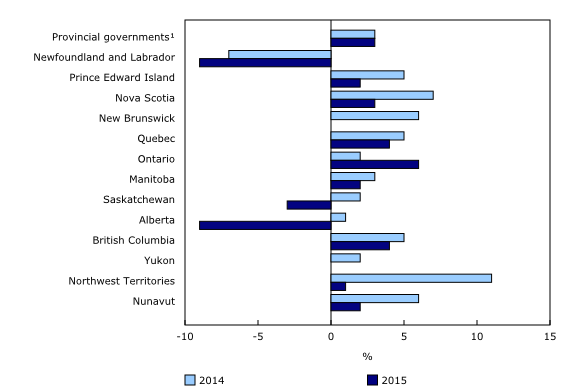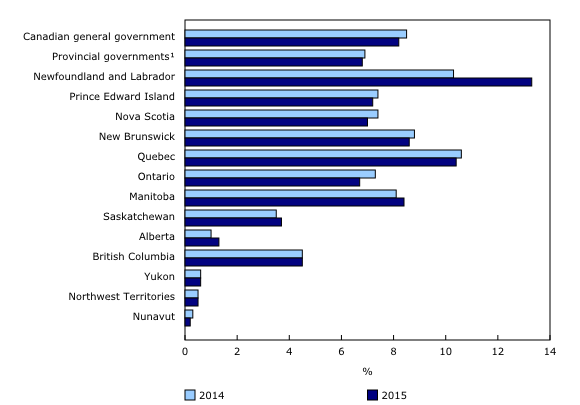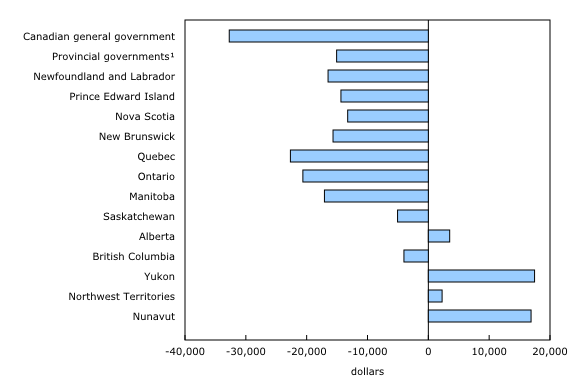Consolidated Canadian Government Finance Statistics, 2015
Archived Content
Information identified as archived is provided for reference, research or recordkeeping purposes. It is not subject to the Government of Canada Web Standards and has not been altered or updated since it was archived. Please "contact us" to request a format other than those available.
Released: 2017-03-29
The total fiscal burden in Canada—tax revenues and social contributions imposed by governments on individuals, businesses and non-residents—was $16,510 per capita in 2015, up from $15,913 in 2014.
In 2015, Canadian general government reported total revenues of $710.8 billion, with taxes and social contributions accounting for 83% of total revenue, up slightly from 82% in 2014. The remainder included revenue from sales of goods and services, property income and other sources.
Consolidated provincial-territorial and local governments (PTLG) revenues amounted to $510.4 billion in 2015, with taxes ($310.9 billion) and social contributions ($12.9 billion) accounting for 63% of the overall total.
The PTLG fiscal burden per capita increased in 8 of 10 provinces, with Ontario (+$502) and Quebec (+$491) recording the largest gains. Lower tax revenues fuelled decreases in Alberta (-$201) and Saskatchewan (-$112).
Among the provinces, Quebec had the highest fiscal burden in 2015 at $10,461 per capita, while New Brunswick had the lowest at $7,119.
Oil and gas royalties revenue decline by two-thirds
In 2015, total consolidated revenue at the provincial-territorial and local governments level increased by 3% to $510.4 billion. But there was significant variation among the provinces and territories.
While Ontario (+6%), Quebec (+4%) and British Columbia (+4%) PTLG recorded the strongest increases among the provinces, revenue declined significantly in Newfoundland and Labrador (-9%), Alberta (-9%) and Saskatchewan (-3%). The decline was closely tied to sharply lower revenue from oil and gas royalties.
In 2015, Canada's PTLG oil and gas royalties revenue totalled $4.4 billion, down 65% from $12.6 billion a year earlier. The decline was concentrated in Alberta ($-6.2 billion), Newfoundland and Labrador ($-0.8 billion) and Saskatchewan ($-0.7 billion).
At the same time, federal government oil and gas royalties revenue decreased by 69% (-$0.5 billion) in 2015.
Federal transfers to the provinces increase slightly
In 2015, $80.1 billion of Canada's consolidated provincial-territorial and local governments revenues came from grants, edging up from $77.7 billion in 2014. PTLG grants are transfers received from the federal government and included the Canada Health Transfer, Canada Social Transfer and fiscal equalization transfer.
Among the provinces, Prince Edward Island received the most grants per capita ($4,546), while British Columbia ($1,729) recorded the least. The territories are highly dependent on federal funding (see table 2 and the note to readers).
Interest expense down for the Canadian general government
The Canadian general government paid 8.2 cents in interest for every dollar of revenue in 2015, or about $58.2 billion in interest expenses. This ratio was down compared with 2014, when it stood at 8.5 cents. All levels of government were able to renew their debt at lower rates of interest in 2015.
The ratio of interest expense to revenue provides a measurement of the public debt burden. The more interest a government has to pay to service debt, the fewer funds it has at its disposal to administer government and deliver services.
Consolidated provincial-territorial and local governments interest expenses totalled $34.7 billion in 2015, up $0.5 billion from 2014.
Among the provinces, Newfoundland and Labrador, at 13.3 cents (10.3 cents in 2014), and Quebec, at 10.4 cents (10.6 cents in 2014), continued to have the highest interest expense-to-revenue ratio in 2015. Alberta (1.3 cents) and Saskatchewan (3.7 cents) had the lowest ratios.
In 2015, the federal government paid 8.3 cents in interest for every dollar of revenue compared with 8.9 cents in 2014.
Canadian general government's net financial worth increased
The Canadian general government's net financial worth increased by 2% in 2015, as growth in financial assets (+7%) outpaced liabilities (+2%).
Canadian general government held $946.6 billion in financial assets, mostly in the form of equity, loans to government business enterprises and accounts receivable. Conversely, the Canadian general government had $2,119.8 billion in liabilities, mostly in the form of debt securities, pension liabilities and accounts payable.
In 2015, Alberta and the three territorial PTLG governments recorded a net financial asset position, whereas every other province was in a net liability position. Net liabilities on a per capita basis were highest in Quebec ($22,671), Ontario ($20,623) and Manitoba ($17,077).
Net financial worth increased for seven PTLG governments. Of those that decreased, Newfoundland and Labrador, Alberta and Saskatchewan had the largest per capita declines, indicative of increased borrowing.

In celebration of the country's 150th birthday, Statistics Canada is presenting snapshots from our rich statistical history.
The evolution of the federal government debt illustrates some of the major national and international political and socioeconomic events that have shaped Canada's 150 year history. Over this period, the nominal federal net debt per capita grew from $22 in 1867 to a record high $19,733 in 1997.
For the full article, see Federal net debt per capita, 1867 to 2016 in today's Daily.
Note to readers
This release includes revisions to both unconsolidated and consolidated Canadian Government Finance Statistics data for the 2013 and 2014 reference periods as well as the addition of the 2015 reference period. Estimates for nonfinancial assets and consumption of fixed capital have been revised back to 2008 to improve the integration of Canadian government finance statistics (CGFS) data with other products of the Canadian Macroeconomic Accounts.
Consolidation is a method of presenting one overarching statistic for a set of units. It involves eliminating all transactions and debtor–creditor relationships among the units being consolidated. In other words, the transaction of one unit is paired with the same transaction as recorded for the second unit and both transactions are eliminated.
Consolidated data are released for the provincial–territorial and local governments (PTLGs), which include provincial and territorial governments, health and social service institutions, universities and colleges, municipalities and other local public administrations, and school boards.
PTLG data can be compared across provinces and territories because consolidation takes into account differences in administrative structure and government service delivery by removing the effects of internal public sector transactions within each jurisdiction.
Consolidated data are also released for the Canadian general government (CGG), which combines federal government data with PTLG data but excludes data for the Canada Pension Plan and Quebec Pension Plan.
Because PTLG finance statistics vary significantly across jurisdictions in Canada, per capita data are used to facilitate comparisons. Per capita data are based on population estimates for Canada, the provinces and the territories, available in CANSIM table 051-0001.
The constitutional framework of PTLGs in the territories differs from that in the provinces, leading to differences in the roles and financial authorities of government.
These differences, as well as other geographic, demographic and socioeconomic dissimilarities between the North and the rest of Canada, give rise to marked disparities in government finance statistics.
In this release, revenues, expenses, assets and liabilities are reported in nominal terms.
In 2015, the consolidation method removed $333.1 billion in internal revenues and expenses, as well as $378.3 billion related to internal debtor–creditor relationships for the CGG.
The fiscal burden is a fiscal indicator derived from the Government Finance Statistics framework. The fiscal burden, defined as revenue in the form of taxes plus social contributions, is a fiscal analysis indicator proposed by the International Monetary Fund.
Net financial worth is defined as the total value of financial assets minus the total value of outstanding liabilities. When financial assets are greater than liabilities the measure is referred to as net financial assets. When liabilities are greater than financial assets the measure is referred to as net liabilities.
Annual data correspond to the end of the fiscal year closest to December 31. For example, data for the federal government fiscal year ending on March 31, 2016 (fiscal year 2015/2016), are reported for the 2015 reference year.
Products
The Canadian Government Finance Statistics 2014 classification structure is now available in the Definitions, data sources and methods module of our website.
Contact information
For more information, or to enquire about the concepts, methods or data quality of this release, contact us (toll-free 1-800-263-1136; 514-283-8300; STATCAN.infostats-infostats.STATCAN@canada.ca) or Media Relations (613-951-4636; STATCAN.mediahotline-ligneinfomedias.STATCAN@canada.ca).
- Date modified:




